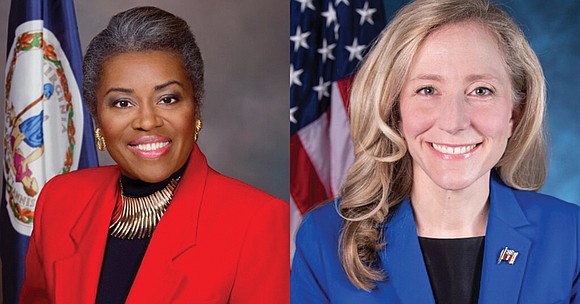Spanberger, Earle-Sears outline workforce plans at education conference
By Nathaniel Cline | 10/16/2025, 6 p.m.

As Virginia seeks to strengthen communities statewide and support economic growth, gubernatorial candidates Abigail Spanberger and Winsome Earle-Sears presented their cases at the Virginia Education & Workforce Conference in Richmond on Tuesday as to why they should be elected to lead these efforts.
The two candidates spoke to more than 400 attendees from business, education and policy backgrounds about the challenges and their respective plans during the conference at the Greater Richmond Convention Center. The event, which focused on building a more skilled and competitive workforce, was co-hosted by the Virginia Chamber Foundation, the Virginia Business Higher Education Council, the VCF Workforce and Education Center and the Virginia Talent + Opportunity Partnership.
Spanberger, the Democratic nominee, addressed improving Virginia’s rating for the Best State to do Business by CNBC. The Commonwealth, consistently ranked a top-three finisher in the past five years, dropped from the top spot to fourth this summer due to the federal job cuts by President Donald Trump’s administration that have disproportionately affected Virginia, home to 147,000 civilian federal employees. The state did maintain its top rating for education for the second straight year.
“We must do everything we can to get Virginia back to number one in the CNBC rankings, and that means strategic investments in workforce training, affordable child care and housing, streamlining permanent shovel-ready sites and reliable infrastructure,” Spanberger said Tuesday morning.
Earle-Sears, the current lieutenant governor and the GOP nominee for governor, did not mention the ranking, but instead explained how collaboration has played a big role in education and workforce development in the Commonwealth. She applauded the Virginia Chamber, which she said “brought together the people who make Virginia’s story possible.”
“(But) this is not a moment for complacency,” Earle-Sears said. “It is a call to strengthen our resolve and sharpen our edge and continue to lead; and under my leadership, Virginia will rise to that challenge. We will maintain not just our domestic competitive advantage, but our international life as well.”
She spoke about how Virginia’s education system shaped her career, urging stakeholders to continue working together to ensure that Virginia has a “phenomenal” workforce across all sectors. She also touted the success of the current administration, led by Republican Gov. Glenn Youngkin, by investing in businesses and teacher training as well as expanding laboratory schools that offer tuition-free specialized instruction in high-demand careers such as teaching, computer science and technology.
Earle-Sears said artificial intelligence poses a rising challenge for Virginia as it competes with countries outside the United States and also supports workforce reentry for groups like veterans and military families.
As governor, Earle-Sears said she would continue the current administration’s priorities of strengthening the workforce and empowering students through rigorous academics and different pathways.
Spanberger noted the cost of living as a sizable challenge, with Virginians navigating rising expenses for health care, housing and energy, and facing uncertainty amid the federal government’s job cuts and shutdown.
The state could do more to support working people by establishing family medical leave, increasing affordable housing supply and child care access and raising the minimum wage, Spanberger suggested.
As for displaced workers, the Democrat proposed ways the state could help identify adjacent job opportunities and expand career mentoring. She also shared plans to strengthen workforce development from early childhood through career training, increase funding for community colleges, expand dual enrollment classes and ensure flexibility in the education system to prepare students for emerging technologies.
“I know there are those who think you can be pro-business or pro-worker, and I wouldn’t be surprised if there’s some people in this room that hold that opinion, but I reject that idea. We can do both,” Spanberger said. “Virginia’s economic success has always come from balancing those forces, and under the right leadership, with the right coalition, we can keep that balance for decades into the future.”
Both candidates also defended their stances of support for Virginia’s right-to-work law, which prohibits employees from being required to join a union or pay union dues as a condition of employment.
Keith Martin, interim president and CEO of the Virginia Chamber, told reporters that the conference is a way for stakeholders from all industries and the candidates for governor to collaborate, as it follows the Blueprint Virginia 2035 that serves as a guide to ensure the Commonwealth remains a top state for business. Historically, the Chamber has not endorsed any candidate.
“We’re working with both candidates for governor,” Martin said. “We’re optimistic in our partnership that we’ll have with the next governor, and the collaboration we have with the business community and higher education moving forward.”
The deadline to register to vote, update registration or apply for a ballot to be mailed is Oct. 24. In-person early voting ends Nov. 1. Election Day is Nov. 4.
This story originally appeared at VirginiaMercury.com.






